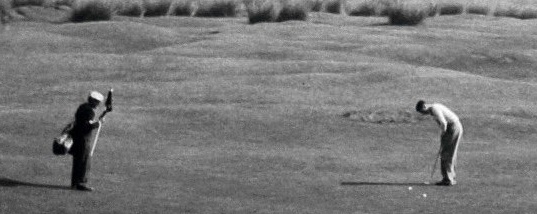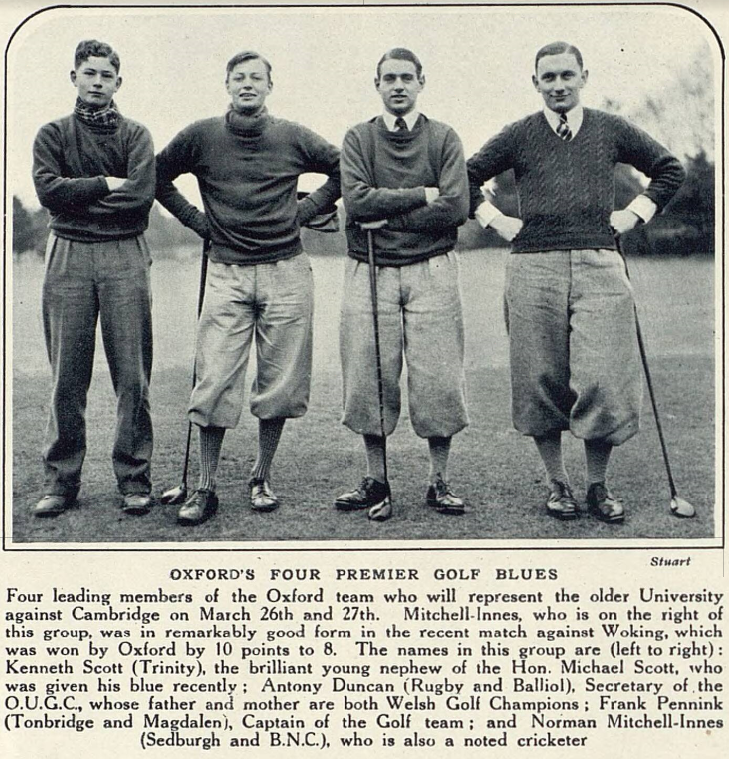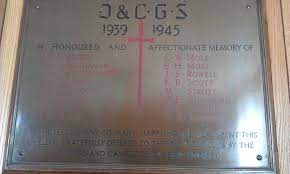August 2004 - How I became a golf collector
How I became a golf collector
As a child my father did a sterling job in dragging me around museums and taking me to air displays. Like many boys before me, this gave me an interest in all things military. On going to University, this interest led me to seek a career within the Armed Forces, however, after a couple of years of being involved with the RAF Volunteer Reserve, I decided that I was not destined to follow this path through life and after graduation I gained employment within the automotive industry. A few years later, whilst watching Antiques Roadshow one Sunday night, a television programme I had loved watching since a teenager, I decided I had to become an antique collector of some kind. At that stage I had no idea of what I should collect. It was probably my interest in the military that gave me the idea of collecting swords. After a few trips around the local second-hand and antique shops it became clear that antique swords are a) often expensive b) dangerous to have around a family home and c) have little practical use apart from scaring the wits out of burglars. My newly found wealth of full-time employed also allowed me to take up a game that I was strangely attracted to; golf. I put this interest down to spending my very early childhood living a stone's throw from a golf course in Fife, Scotland. I never actually played the game as a child, as when I was six my family moved to the Midlands in England and nobody I knew played the game or had the money to. In the autumn of 1995 my desire to start a collection of historical items collided with my favourite sporting pastime. Whilst browsing through a junk shop in Dorset on a Saturday afternoon I spotted a single old putter. Eureka! Collecting old golf clubs was to be my thing!
After inspecting this single club I enquired whether they had any others. The shopkeeper casually replied " well, no....apart from the others in that bag". Before I had even inspected the contents I had decided this old bag stuffed full of clubs was going to be mine. A quick deal was done and I left the shop to meet up with my wife and friends who had strolled on along the street. On seeing these rusty objects my wife exclaimed I was mad, as did my friends. I did not care, however, as I was now officially a "collector". Later that night I cleaned the very small spots of surface rust from the clubs until they gleamed and pondered their origin. The canvas and leather bag was clearly stencilled with a name, there was a small paper label attached with an address, and the clubs themselves were stamped "Oxford University Golf Club". The numbers on the irons ran consecutively, there were three woods, a putter and a sand wedge. With my scant knowledge of modern golf, I realised I had stumbled upon a complete set. My inquisitiveness grew and I became more and more intrigued about how this set of clubs had come to be in a junk shop. With the information that I had, i.e. name, address and university, I figured I had a good chance of tracing something about the original owner.
Around this time I had become enlightened as to the usefulness of the Internet, especially for the use of genealogy. At work on the following Monday, I logged on to the Internet (access of course had been granted to me for strict business purposes only!), and entered some of the details that I had into one of the major search engines. I discovered that J.H.Taylor and Gene Sarazen, who's names were stamped on the irons and sand wedge respectively, were famous golfers, and that Sarazen had indeed been credited with inventing the sand wedge in the inter-war years. The descriptions of "faux wood" steel shafted clubs used in the 'thirties matched those that I possessed. With my engineering background I knew when I bought them that they weren't genuine "hickories" and the price paid reflected that. My Internet search regarding the owners name and address drew a complete blank, which did not surprise me. I thought I had reached the pinnacle of what I was able to discover about the clubs. I continued surfing the net for a short while. This included checking if a site that was dedicated to the Leicestershire Regiment had published some photographs I had submitted of my grandfather who had been killed in the Second World War. My mind came up with an idea. Was it possible that these vintage clubs were in such good order because nobody had actually played with them since the nineteen-thirties, and indeed could the owner have been killed in the war? I knew exactly where to check this hunch. The website of the Commonwealth War Graves Commission (www.cwgc.org) lists the names of the fallen of both World Wars. I entered the surname and initials I had into the database and pressed search. As the death record flashed up I felt elation yet sadness.
The details on the screen corroborated exactly with the information I had. The "K.B.SCOTT" stencilled on the bag was Major Kenneth Bertram Scott M.C of the West Kent Regiment, who died aged 27 in 1943 during the invasion of Sicily. He carried the post-nom of M.A(Oxon), which tallied as the clubs were stamped "Oxford University Golf Club", and his parents and widow had lived in Tadworth, Surrey. From the address label on the bag I knew he had actually lived at a house called "Red Lodge" within that town.
I spared a thought how his parents, Osmund and Mary, and his wife Denise, must have reacted when the news came through of his death. Had they openly cried or had they privately shed their tears behind their well-to-do British stiff upper lips? I wondered whether Major Scott had won his Military Cross posthumously? I also wondered if he had any direct descendants still living; the death record had not listed any children. I imagined an oak plaque within a quite collegiate chapel carrying his name and rank in gold letters, upon which his friends and past tutors would look and proudly say to themselves " an MC, well done old boy, good show".
A day or so later I received a reply to my email enquiry I had made to the Registrar of Oxford University. Scott had matriculated through Trinity College in 1934 and read English History, Military History and Latin Authors. He had passed the qualifying examination in 1939, but they could not tell me whether he had been awarded any sporting merits. I relayed the tale of these clubs to family and friends, who would listen, and hoped that one day I would have time to locate a photograph of "the Major". I thought Trinity College may have a formal year photograph, amongst hundreds lining the hallowed corridors, or that the local Tadworth newspaper may have carried an obituary of some kind. I also found out that the Public Record Office carries records of all citations for gallantry decorations including the Military Cross.
The discovery of these clubs had opened a door into a new world that until that point I had never known existed. I wanted to find out more about the names of George Nicoll, J.H.Taylor and Gene Sarazen. The next weekend I scoured more junk shops and picked up a bag of seven wood shafted clubs. The excitement of scouring the Internet for information about a certain marking or name really fired my enthusiasm. I even found that complete reference books on the subject had been published! I was well and truly hooked. After a couple of months and as the proud owner of a collection of twenty hickories I thought I knew my subject pretty well. Every new club or book purchase, however, would reveal more of this hidden world and make me reflect with amazement on how little I must have known before! (The process continues to this day!). My weekends were filled with behaviour that I'm sure is demonstrated by collectors in many fields. It did not seem at all irrational to drive over 200 miles in a weekend, cover five counties, visit up to thirty antique shops, and bring home two old wooden sticks worth a total of twenty pounds. It took me about two years to realise that this type of weekend cross-country treasure hunting costs a lot in petrol, has to be done alone (I can do a three hundred stall antique fair in twenty minutes before any compatriots have covered two stalls), and provides little material rewards.
Like other collectors, my main source for clubs and associated items now tends to be specialist auctions. At such a forum in December 2003 I spied a book being sold by a prominent collector on his stall to the side of the main auction titled "110 Golf Matches- Oxford v Cambridge 1878-1999 by John Gillum. Once purchased, a quick browse in the index confirmed what I had hoped for. Ken Scott had been a very competent golfer and had earned a sporting blue for each of his varsity years and the team's Captaincy in 1938. I flicked through the pages dedicated to the matches played in the twilight years of peace preceding the war and there for 1937 was a picture of the Oxford and Cambridge teams en-masse with their names below arranged as to allow identification of each individual. The face of the then twenty-two year old Scott seemed serious and much older than his years, which strangely seems to be common phenomena with photographs of bygone ages. To his right is sitting P.B "Laddie" Lucas, who would within a couple of years become a well known fighter pilot leading the defence of Malta, and throughout his life an influential figure in the golfing world. Of the twenty-four faces in the photograph, a quick search of the War Graves website reveals eight of them would not see the end of the war, their deaths spanning all theatres of the conflict from the Battle of Britain to the Burmese jungles. Again, I thought that I had reached the end of the tale of the Major's clubs.
The collector from whom I had bought the book enquired as to whether it had more than a passing interest to me. I relayed my tale to him and he expressed interest, muting the idea of Ken Scott being of the "Scott family", which meant little to me at the time. A few days after the auction he telephoned me to say that he had found a reference to Ken Scott "the international golfer, like his father and brother" finishing second in the President's putter at Rye in the late 'thirties. He again stated a connection to the Scott family. A quick surf on the internet revealed the connection. Ken Scott was the nephew of Lady Margaret Scott; the Ladies Open Champion 1893, 1894 and 1895 and undoubtedly the most gifted lady golfer of her time. Lady Margaret learned her golf on the estate of her father, the Earl of Eldon, whilst playing with her brothers, the youngest of whom Osmund, was Ken Scott's father. The second brother, Michael, went on to become the oldest winner of the Amateur Championship in 1933 before emigrating to Australia. Once this pedigree was revealed, it became clear why Ken Scott was a skilled golfer. More than that he was also a first class cricketer, as was his father and elder brother Harold, and had played for Surrey. The same website revealed that his brother Harold had outlived him by some fifty-four years dying at the age of ninety in Dorset. My quest to discover the story of these clubs had turned virtually full-circle. Like many objects acquired by collectors, they were most likely just part of the house contents cleared following a death. I still ponder quite a few questions about them, such as why it appears they were never used post-war? I'm sure lots of young lads would have put them to good use in those austere years. Further searching on the Internet has revealed that the aristocratic Scott family are still very much in existence. I have thought about contacting them to relate this tale but I'm afraid they might think me a little weird with my interest in their family.
Finding and discovering the tale behind these clubs was the catalyst for what has grown into a huge part of my life, namely golf collectibles. It has also caused me to think more about the story behind each club that I find which has personal markings. Some collectors view personal markings, often crudely scored, as detrimental to clubs; I view them as a distinct bonus. On a wider note, these clubs have postulated a further theory in my mind. It is known that many millions of hickory clubs were made pre-First World War and that millions may still exist. Maybe the combined effects of war, deadly outbreaks of influenza and tuberculosis, and the economic depression of the 1930's all had a perversely positive effect on the numbers of hickory clubs in existence today. Survival, not golf, was high on the agenda for many families and individuals, and by the time the population at large was ready and affluent enough to again pursue leisure activities such as golf, club design and manufacturing methods had moved on.
The next time you find a personally marked golfing collectible and are curious about it's owner, it is worth considering that they may be among those listed on the War Graves Commission website. These individuals secured tee-off times on the eternal Old Course much earlier than expected, and I hope they are having great matches.
Update since this article was written: In about 2010 a member of the Scott family contacted me saying they'd found like article online and had enjoyed reading it. The told me some other details about Ken Scott, but to respect their privacy I will not elaborate. I'm a little sad to say that in about 2012 I sold the bag of clubs. I believe they are now on display in a golf museum in China which on balance is probably better than them gathering dust in a corner of my garage. So Major Scott, thank you for stimulating my latent passion in antique golf equipment and golf history.
K.B.Scott seated 2nd Row Up, 3rd from right. Oxford and Cambridge University Golf Teams 1937 Photograph reproduced by permission
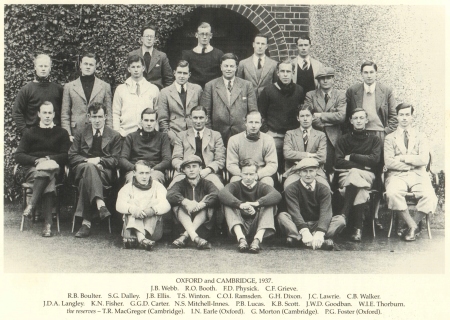
****** UPDATE : January 2021********
Shortly before Christmas 2020, with the country in the grip of the COVID-19 virus pandemic, (as we still are as I write on 12th Jan 2021), I was browsing through things for sale on eBAY. I often like to look at things that are for sale in Southam, the small town of approx 10,000 people, in Warwickshire, in which I live. I set the eBAY filters to local accordingly. The first thing that was listed was an old magazine. I noticed immediately that one of the pictures in the listing appeared to show golfers. I clicked on the pic to enlarge it to get a better view. There was a picture of three golfers confidently striding towards the camera. I looked at the man in the centre and although the hairs on the back of my neck did not tingle I had a very strange feeling. The young man in the centre of the photograph is Ken Scott. I'm not a religous, nor superstitous person, but one has to ask oneself "what are the chances?".
What are the chances of this magazine surviving from the day it was published, February 26th 1937?
What are the chances that ths magazine should belong to someone who lives a mere few hundred yards away from my home?
What are the chances that I happened to be browsing eBAY at the time that they decided to sell it?
What are the chances that the central person in the story above should be the person pictured?
I wouldn't even know how to begin calculating the chances of all this happening...but happen it did. I pressed the "Buy It Now" button and purchased the magazine for a few pounds. And here are the pics from that magazine showing Ken Scott as a fresh faced young man playing golf for Oxford University.
Ken Scott is shown partnering C.I.Ramsden. Other people pictured are J.C.Lawrie and and N.S.Mitchell-Innes.
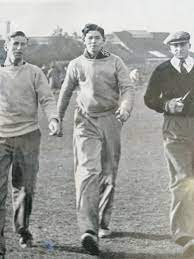
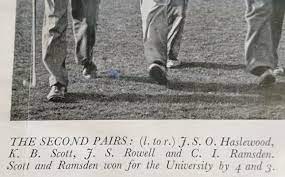
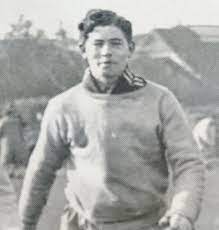
Whilst writing this update I remembered something else I had once come across. In 2012 I visited Rye Golf Club to play in the English Hickory Championship. I was having a drink in the clubhouse afterwards when I looked up and saw this plaque on the wall. There was a familiar name. May they rest peacefully. They shall not grow old.
***********
Update 3rd March 2022
A quick search on the internet revealed this image of Kenneth Scott playin golf at Worplesdon on the 13th October 1936
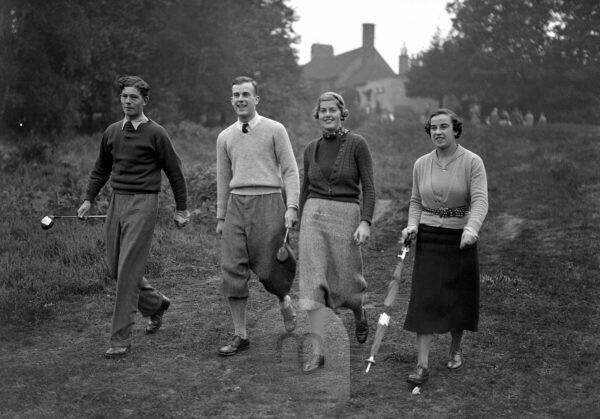
Kenneth Scott, Mr J Craddock Hartopp , Miss Mervyn Barton And Miss G Craddock Hartopp.

